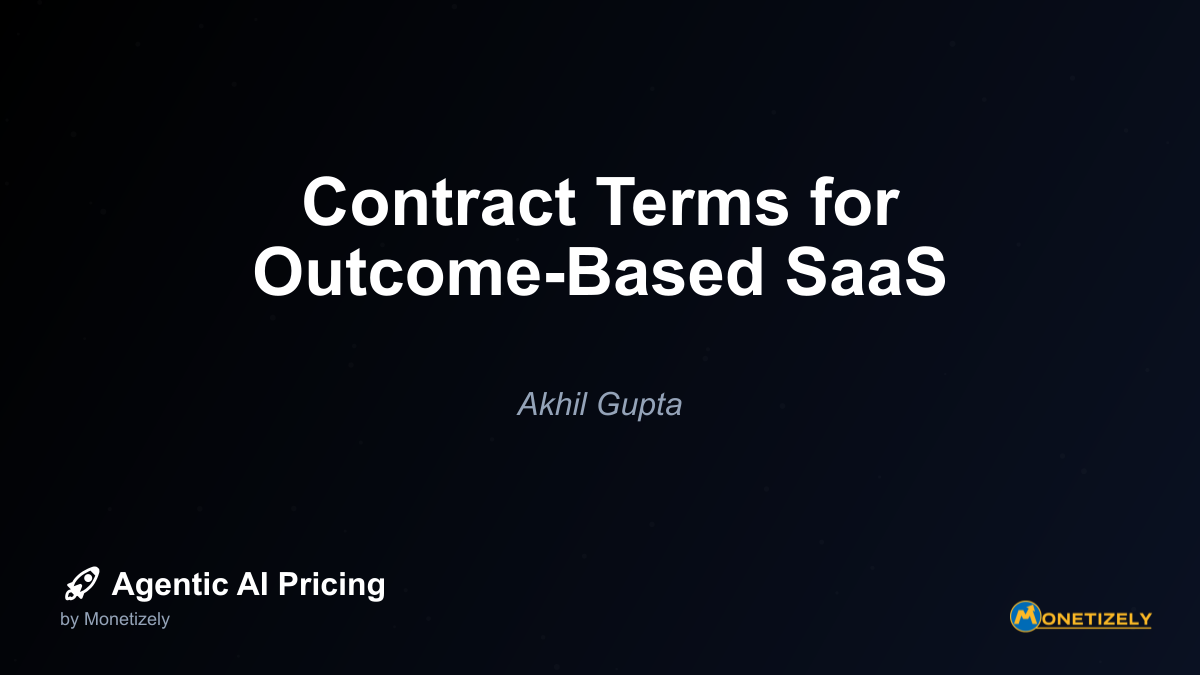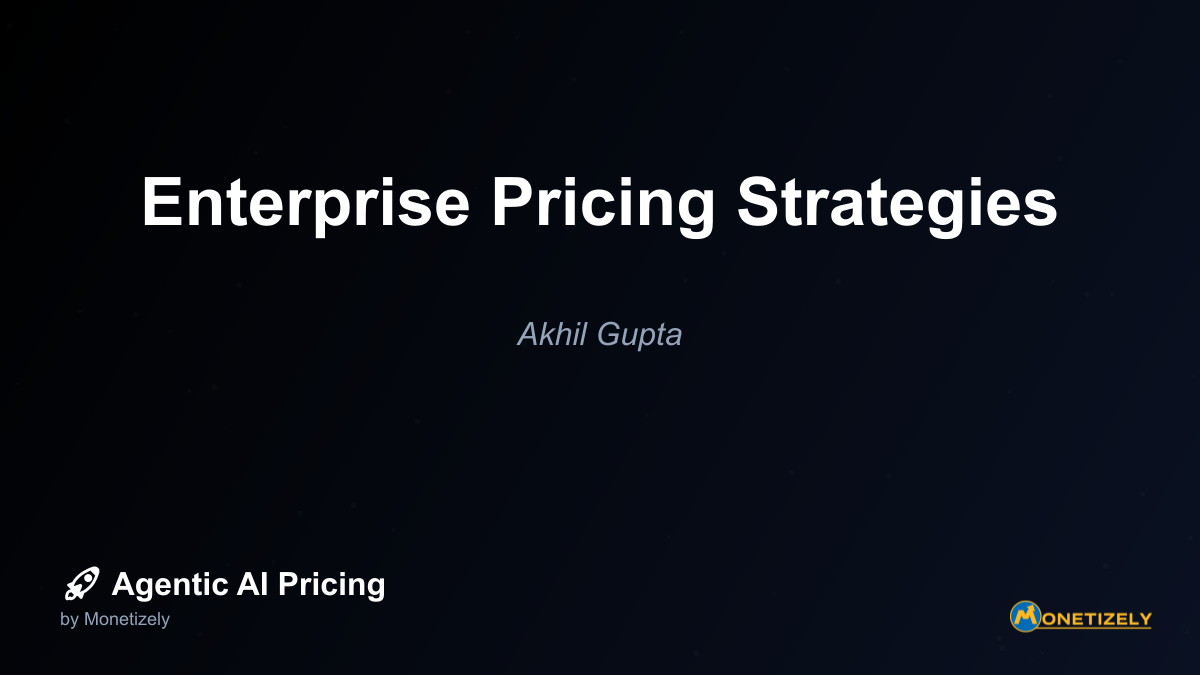· Akhil Gupta · Pricing Agentic SaaS Products · 12 min read
Contract Terms for Outcome-Based SaaS
AI and SaaS Pricing Masterclass
Learn the art of strategic pricing directly from industry experts. Our comprehensive course provides frameworks and methodologies for optimizing your pricing strategy in the evolving AI landscape. Earn a professional certification that can be imported directly to your LinkedIn profile.

Now I’ll create a comprehensive blog post on contract terms for outcome-based SaaS, focusing on legal and financial implications.
In today’s rapidly evolving SaaS landscape, traditional subscription models are giving way to more innovative pricing approaches that better align vendor success with customer outcomes. Outcome-based pricing represents a fundamental shift in how software is monetized, creating both opportunities and challenges for all parties involved. This evolution is particularly pronounced in the realm of agentic AI, where autonomous systems can deliver measurable business results that transcend traditional usage metrics.
The Evolution of SaaS Contract Models: From Subscriptions to Outcomes
Traditional SaaS contracts have historically relied on subscription-based models that charge customers based on factors like the number of users, features accessed, or time periods. While these models provide predictable revenue streams for vendors, they often fail to align pricing with the actual value delivered to customers.
Outcome-based contracts fundamentally reimagine this relationship by tying compensation directly to measurable business results. Rather than paying for access to software, customers pay for the specific outcomes that software helps them achieve. This approach creates a more equitable relationship where vendors are incentivized to ensure customer success, and customers only pay for demonstrable value.
The shift toward outcome-based pricing has been accelerated by several factors:
- Increasing competition in the SaaS market, forcing vendors to differentiate through value-based approaches
- Growing customer sophistication and demand for ROI-driven investments
- Advances in measurement capabilities that enable more precise tracking of outcomes
- The emergence of agentic AI that can deliver and measure specific business results
By 2025, research indicates that nearly 40% of SaaS companies will have experimented with or fully adopted outcome-based pricing models, moving away from traditional subscription approaches toward pricing tied to actual business outcomes or operational results.
Key Components of Outcome-Based Contracts
Crafting effective outcome-based contracts requires careful attention to several critical components:
1. Defining Clear, Measurable Outcomes
The foundation of any outcome-based contract is the clear definition of what constitutes success. These outcomes must be:
- Specific and quantifiable: Vague promises of “improved performance” are insufficient; contracts must specify exact metrics like “20% reduction in customer support response time” or “15% increase in conversion rates.”
- Objectively measurable: Both parties must agree on measurement methodologies, data sources, and calculation formulas.
- Time-bound: Contracts should specify the timeframe within which outcomes are expected to be achieved.
- Attributable: The contract should address how to isolate the impact of the software from other factors that might influence outcomes.
For example, ServiceNow has implemented outcome-based pricing by guaranteeing specific efficiency improvements for enterprise customers. The company charges full rates only when these targets are met, creating a strong incentive to deliver measurable results.
2. Compensation Structures and Payment Terms
Outcome-based contracts can employ various compensation structures:
- Pure outcome-based: Payment is entirely contingent on achieving specific outcomes.
- Hybrid models: A base fee plus variable compensation tied to outcomes, which helps balance risk for both parties.
- Tiered pricing: Different payment levels based on the degree of success achieved.
- Gain-sharing arrangements: Vendor and customer share in the financial benefits of achieved outcomes.
HubSpot, for instance, has experimented with performance tiers where customers can unlock reduced rates by achieving predetermined marketing and sales metrics. This approach incentivizes customer success while providing a flexible pricing structure.
3. Risk Allocation and Mitigation Clauses
Outcome-based contracts inherently involve risk-sharing between vendors and customers. Effective contracts include mechanisms to manage these risks:
- Minimum guarantees: Establishing floor payments to ensure vendors receive some compensation regardless of outcome achievement.
- Caps on upside/downside: Limiting the maximum reward or penalty to create predictability for both parties.
- Force majeure provisions: Addressing circumstances beyond either party’s control that might affect outcome achievement.
- Renegotiation triggers: Identifying conditions that would warrant revisiting contract terms.
Legal Considerations for Outcome-Based Contracts
Outcome-based contracts introduce unique legal challenges that must be carefully addressed to protect both parties.
1. Liability Limitations and Indemnification
Given the increased stakes of outcome-based arrangements, liability clauses become particularly critical:
- Limitation of Liability (LOL): SaaS vendors typically include LOL clauses to cap their financial exposure, often limiting recoverable damages if the service fails to deliver promised outcomes.
- Indemnification: Contracts should specify indemnification obligations, particularly for AI-powered SaaS, to protect against IP infringement claims and third-party claims arising from AI errors or misuse of AI outputs.
- Warranty disclaimers: Vendors may disclaim warranties for modifications or combinations of the service outside their control.
According to legal experts, outcome-based contracts should carefully balance risk allocation while maintaining appropriate liability protection for both parties. This often means negotiating higher liability caps than traditional SaaS contracts to reflect the increased vendor responsibility for delivering specific outcomes.
2. Intellectual Property and Data Rights
Clear terms around data ownership and usage rights are essential in outcome-based contracts:
- Data ownership: Contracts should explicitly define who owns the data created or input into the system.
- Usage rights: Specify rights to use customer data for AI training and system improvement.
- Data return/deletion: Outline responsibilities regarding data return or deletion after contract termination.
These considerations become particularly important for AI-powered services, where data may be used to train models that benefit other customers or the vendor’s broader business. Contracts should address whether and how customer data can be used beyond direct service provision.
3. Performance Guarantees and Service Level Agreements (SLAs)
Outcome-based contracts must include robust performance guarantees:
- SLA definitions: Clearly define service levels, response times, and system availability requirements.
- Measurement methodologies: Specify how performance will be measured and verified.
- Remedies for non-performance: Detail the consequences of failing to meet guaranteed service levels, such as service credits, fee reductions, or termination rights.
For instance, Zendesk has implemented outcome-based pricing for its AI agents, where customers pay depending on the resolution of customer support tickets. The contract clearly defines what constitutes a “successful resolution” and includes specific performance guarantees.
4. Termination and Exit Provisions
Given the higher stakes of outcome-based contracts, termination clauses require careful consideration:
- Termination for non-performance: Define the threshold of underperformance that would trigger termination rights.
- Wind-down periods: Specify transition assistance and data migration support upon termination.
- Post-termination obligations: Outline ongoing obligations regarding data security, confidentiality, and intellectual property.
Financial Implications of Outcome-Based Contracts
Outcome-based contracts create significant financial implications for both vendors and customers that must be addressed in the contract terms.
1. Revenue Recognition Challenges
For SaaS vendors, outcome-based pricing introduces complexity in revenue recognition:
- Variable consideration: Under accounting standards like ASC 606 and IFRS 15, variable payments tied to outcomes may need to be estimated at contract inception, with adjustments made as outcomes are achieved.
- Performance obligations: Contracts must clearly define when performance obligations are satisfied to determine when revenue can be recognized.
- Constraints on variable consideration: Companies may need to apply constraints on variable consideration to avoid significant revenue reversals.
To address these challenges, contracts should include clear milestones and measurement periods that facilitate proper revenue recognition while complying with accounting standards.
2. Financial Risk Management
Both parties must manage the financial risks inherent in outcome-based contracts:
- Cash flow implications: Vendors may experience more variable cash flows, requiring financial buffers and sophisticated forecasting.
- Budgeting challenges: Customers may face difficulty budgeting for variable payments tied to outcomes.
- Financial reporting: Both parties may need to adapt financial reporting processes to account for outcome-based arrangements.
Companies like ServiceNow and Workhuman have addressed these challenges by implementing hybrid models that combine fixed baseline fees with outcome-based components, providing some stability while maintaining the incentive alignment of outcome-based pricing.
3. ROI Calculation and Value Attribution
Outcome-based contracts require robust methodologies for calculating ROI and attributing value:
- Baseline establishment: Contracts should specify how pre-implementation baselines will be established to measure improvement.
- Value attribution: Define methodologies for isolating the impact of the software from other factors.
- ROI calculation formulas: Include specific formulas for calculating return on investment.
For example, Siemens has implemented outcome-based pricing for its energy management software by guaranteeing specific percentage reductions in energy costs. The contract includes detailed methodologies for measuring baseline energy consumption and calculating actual savings attributable to the software.
Industry-Specific Considerations for Outcome-Based Contracts
The implementation of outcome-based contracts varies across industries, with each sector facing unique challenges and opportunities.
1. Healthcare SaaS
In healthcare, outcome-based contracts often focus on clinical outcomes, patient satisfaction, or operational efficiency:
- Regulatory compliance: Contracts must address HIPAA compliance and other healthcare regulations.
- Clinical outcome measurement: Define methodologies for measuring clinical outcomes while controlling for patient variables.
- Risk adjustment: Include mechanisms to adjust for patient population differences that might affect outcomes.
2. Marketing and Sales SaaS
For marketing and sales software, outcomes typically revolve around revenue generation or customer acquisition:
- Attribution models: Specify methodologies for attributing sales or conversions to the software.
- Pipeline impact measurement: Define how impact on sales pipeline will be measured and valued.
- Customer lifetime value calculations: Include formulas for calculating changes in customer lifetime value.
3. Financial Services SaaS
In financial services, outcome-based contracts often focus on risk reduction, compliance improvement, or operational efficiency:
- Regulatory considerations: Address compliance with financial regulations and data protection laws.
- Risk reduction measurement: Define methodologies for measuring changes in risk profiles.
- Security requirements: Include specific security standards and certification requirements.
Implementing Outcome-Based Contracts for AI-Powered Services
AI-powered services, particularly those leveraging agentic AI, present unique considerations for outcome-based contracts.
1. Defining AI-Specific Outcomes
Contracts for AI-powered services must define outcomes that reflect the unique capabilities of the technology:
- Automation efficiency: Measure reduction in manual work through automation.
- Decision quality improvement: Assess improvements in decision accuracy or quality.
- Predictive performance: Evaluate the accuracy and business impact of AI predictions.
For instance, Zendesk’s outcome-based pricing for AI agents focuses on successful resolution of customer support tickets, with clear definitions of what constitutes a “successful resolution” and how it will be measured.
2. Managing AI-Specific Risks
AI introduces unique risks that must be addressed in outcome-based contracts:
- Algorithm bias: Include provisions for monitoring and addressing potential bias in AI systems.
- Explainability requirements: Specify the degree of transparency and explainability required for AI decisions.
- Continuous improvement obligations: Define vendor obligations for ongoing model improvement and updates.
3. Data Usage and Training Rights
AI systems require data for training and improvement, necessitating clear contract terms around:
- Training data rights: Specify whether and how customer data can be used for model training.
- Model ownership: Clarify ownership of AI models developed or improved during the contract term.
- Cross-customer learning: Address whether insights gained from one customer can benefit others.
Case Studies: Successful Implementation of Outcome-Based Contracts
Several companies have successfully implemented outcome-based contracts, providing valuable lessons for others considering this approach.
Case Study 1: ServiceNow
ServiceNow has piloted outcome-based pricing with select enterprise customers, focusing on guaranteeing specific efficiency improvements:
- Implementation: Customers are charged full rates only when efficiency targets are met.
- Challenge: The model requires sophisticated measurement capabilities and clear economic impact clarity.
- Result: This approach fosters a strong partnership mindset by aligning vendor incentives with customer success, potentially reducing churn and enhancing customer trust.
Case Study 2: InsideSales.com (now XANT)
This sales acceleration platform pioneered “performance pricing” where costs are tied directly to improvements in sales metrics:
- Implementation: Pricing is linked to measurable improvements in conversion rates and deal velocity.
- Challenge: Accurately attributing customer success to the platform’s contribution.
- Result: By linking revenue to measurable outcomes, this model has enhanced ROI and customer satisfaction.
Case Study 3: Workhuman
Workhuman uses an outcomes-based approach by guaranteeing ROI against agreed-upon metrics:
- Implementation: Rather than charging seat-license fees, the company guarantees specific ROI metrics.
- Challenge: Ensuring that agreed-upon metrics are mutually beneficial and quantifiable.
- Result: This model has been successful for over a year, emphasizing the importance of aligning financial incentives with customer outcomes.
Negotiation Strategies for Outcome-Based Contracts
Successful negotiation of outcome-based contracts requires careful preparation and strategy from both vendors and customers.
1. For SaaS Providers
SaaS providers should consider the following negotiation strategies:
- Start with a pilot program: Begin with a limited implementation to test the approach before full-scale deployment.
- Propose hybrid models: Combine traditional subscription elements with outcome-based components to balance risk.
- Focus on high-impact outcomes: Identify outcomes that deliver clear, measurable value to customers.
- Prepare for longer sales cycles: Recognize that outcome-based contracts often require more extensive negotiation and stakeholder buy-in.
2. For Customers
Customers should approach outcome-based contract negotiations with these strategies:
- Clarify organizational needs: Clearly define what success looks like for your organization.
- Research market benchmarks: Understand industry standards for similar outcomes.
- Ensure measurement transparency: Push for transparent, mutually agreed measurement methodologies.
- Negotiate balanced risk sharing: Seek appropriate balance of risk and reward between both parties.
3. Building Mutual Understanding
Both parties should focus on building mutual understanding through:
- Active communication: Engage in open dialogue about needs, constraints, and objectives.
- Joint value creation: Focus on creating shared value rather than zero-sum negotiation.
- Regular review mechanisms: Include provisions for periodic review and adjustment of contract terms.
Compliance and Regulatory Considerations
Outcome-based contracts must address various compliance and regulatory requirements, particularly for AI-powered services.
1. Data Protection Regulations
Contracts should address compliance with data protection regulations such as:
- GDPR: Include provisions for data subject rights, lawful processing, and cross-border data transfers.
- CCPA/CPRA: Address California privacy requirements if applicable.
- Industry-specific regulations: Consider healthcare (HIPAA), financial (GLBA), or other sector-specific requirements.
2. AI-Specific Regulations
Emerging AI regulations may impact outcome-based contracts for AI-powered services:
- EU AI Act: Address risk classification and compliance requirements under the EU’s AI regulatory framework.
- Algorithmic accountability: Include provisions for algorithm transparency and accountability.
- Ethics frameworks: Incorporate adherence to established AI ethics principles.
3. Contract Enforceability
Ensure contract enforceability by addressing:
- Jurisdiction and governing law: Specify which laws govern the contract.
- Dispute resolution mechanisms: Include arbitration or mediation provisions.
- Evidence standards: Define standards for evidence of outcome achievement.
Risk Management in Outcome-Based Contracts
Effective risk management is essential for successful outcome-based contracts.
1. Identifying and Allocating Risks
Contracts should clearly identify and allocate various risks:
- Implementation risks: Address potential challenges in implementing the solution.
- Performance risks: Allocate responsibility for failure to achieve outcomes.
- External factors: Consider how external factors beyond either party’s control will be handled.
2. Monitoring and Governance
Establish robust monitoring and governance mechanisms:
- Joint steering committees: Create governance structures with representatives from both parties.
- Regular performance reviews: Schedule periodic reviews of outcome achievement.
- Escalation procedures: Define processes for addressing performance issues or disputes.
3. Continuous Improvement
Build in mechanisms for continuous improvement:
- Learning cycles: Establish processes for incorporating lessons learned.
- Adaptation provisions: Include flexibility to adapt metrics or methodologies based on experience.
- Innovation incentives: Create incentives for ongoing innovation and improvement.
Future Trends in Outcome-Based Contracting
The landscape of outcome-based contracts continues to evolve, with several emerging trends shaping future developments.
1. AI and Automation in Contract Management
AI-powered contract management tools are streamlining the creation, negotiation, and monitoring of outcome-based contracts:
- Automated performance tracking: AI systems can continuously monitor outcome achievement.
- Smart contracts: Blockchain-based smart contracts may automate payments based on verified outcomes.
- Contract analytics: AI tools can analyze contract performance and suggest optimizations.
2. Increased Standardization
As outcome-based contracts become more common, we’re seeing increased standardization:
- Industry benchmarks: Development of industry-specific outcome benchmarks and measurement standards.
- Contract templates: Emergence of standardized templates for common outcome-based arrangements.
- Best practice frameworks: Establishment of recognized best practices for outcome definition and measurement.
3. Integration with Broader Value-Based Ecosystems
Outcome-based contracts are increasingly integrated with broader value-based ecosystems:
- **Multi-vendor
Co-Founder & COO
Akhil is an Engineering leader with over 16+ years of experience in building, managing and scaling web-scale, high throughput enterprise applications and teams. He has worked with and led technology teams at FabAlley, BuildSupply and Healthians. He is a graduate from Delhi College of Engineering and UC Berkeley certified CTO.
Pricing Strategy Audit
Let our experts analyze your current pricing strategy and identify opportunities for improvement. Our data-driven assessment will help you unlock untapped revenue potential and optimize your AI pricing approach.




